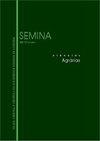Tolerance of cultivars and clonal selections of peach rootstocks to excess aluminum
IF 0.5
4区 农林科学
Q4 AGRICULTURE, MULTIDISCIPLINARY
引用次数: 0
Abstract
Forms of aluminum (Al) present in the solution of tropical and subtropical soils can cause toxicity in rootstocks and peach cultivars, impairing growth and productivity. This can be minimized by growing Al-tolerant rootstocks and cultivars. However, this is not sufficiently known, especially because plant breeding programs do not always consider tolerance as a selection variable for genetic materials. The study aimed to (a) select cultivars and clonal selections of Al-tolerant peach rootstocks, (b) identify variables that confer Al tolerance for use in genetic improvement programs, and (c) propose critical levels (NC) and ranges of toxicity (TF) of Al in relation to morphological variables of the root system. The experimental design was completely randomized, comprising a factorial of 13 (cultivars and clonal selections) x 2 (with and without Al) with three replications. Own-rooted ‘BRS Mandinho’ peach seedlings (without rootstock) and grafted seedlings of ‘BRS Mandinho’ on different cultivars and clonal rootstock selections were cultivated in a hydroponic system, composing two levels for the Al factor (absence and presence at 100 mg L−1). The morphological variables of the canopy and root system, Al accumulation in tissues, translocation factor, and the critical level (NC) and toxicity range (TF) of Al in the roots were evaluated. Rootstocks FB-SM-09-43, JB-ESM-09-13, SAS-SAU-09-71, SS-CHI-09-40, ‘Sharpe’ and VEH-GRA-09-55 were tolerant at high Al concentrations. The NC of Al in the roots in relation to the root surface area of peach rootstocks was 1400 mg Al kg−1, and the FT was between 1200 and 1500 mg Al kg−1.桃砧木品种对过量铝的耐受性及无性系选择
热带和亚热带土壤溶液中存在的铝(Al)形式会对砧木和桃品种造成毒性,损害生长和生产力。这可以通过种植耐铝砧木和品种来减少。然而,这一点还不够清楚,特别是因为植物育种计划并不总是将耐受性作为遗传物质的选择变量。本研究旨在(a)选择耐铝桃砧木的品种和无性系,(b)确定用于遗传改良计划的铝耐受性变量,(c)提出与根系形态变量相关的铝的临界水平(NC)和毒性范围(TF)。试验设计完全随机化,包括13(品种和克隆选择)× 2(含和不含人工智能)的因子,3个重复。在水培系统中,对不同品种和无性系砧木上的‘BRS Mandinho’自根桃幼苗(无砧木)和嫁接的‘BRS Mandinho’幼苗进行培养,在100 mg L−1条件下,组成两个水平的Al因子(无Al因子和有Al因子)。评价了冠层和根系形态变量、组织中Al积累量、转运因子、根系中Al的临界水平(NC)和毒性范围(TF)。砧木FB-SM-09-43、JB-ESM-09-13、sas - su -09-71、SS-CHI-09-40、‘Sharpe’和VEH-GRA-09-55耐高浓度铝。与桃砧木根表面积相关的根系中Al的NC值为1400 mg Al kg - 1, FT值在1200 ~ 1500 mg Al kg - 1之间。
本文章由计算机程序翻译,如有差异,请以英文原文为准。
求助全文
约1分钟内获得全文
求助全文
来源期刊

Semina-ciencias Agrarias
农林科学-农业综合
CiteScore
1.10
自引率
0.00%
发文量
148
审稿时长
3-6 weeks
期刊介绍:
The Journal Semina Ciencias Agrarias (Semina: Cien. Agrar.) is a quarterly publication promoting Science and Technology and is associated with the State University of Londrina. It publishes original and review articles, as well as case reports and communications in the field of Agricultural Sciences, Animal Sciences, Food Sciences and Veterinary Medicine.
 求助内容:
求助内容: 应助结果提醒方式:
应助结果提醒方式:


